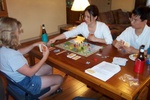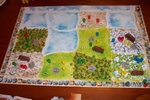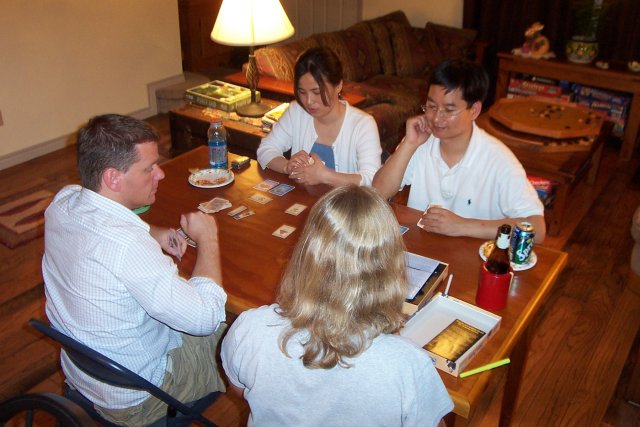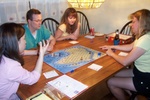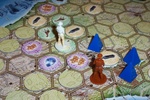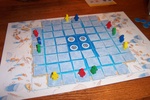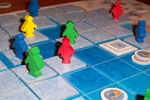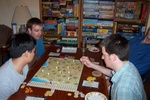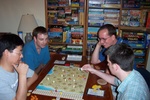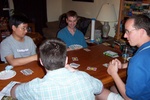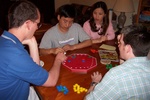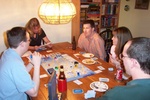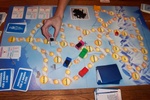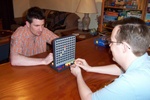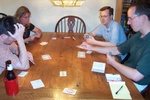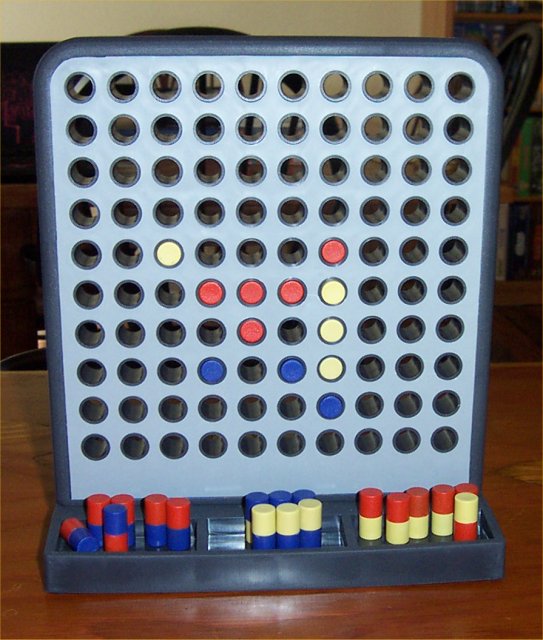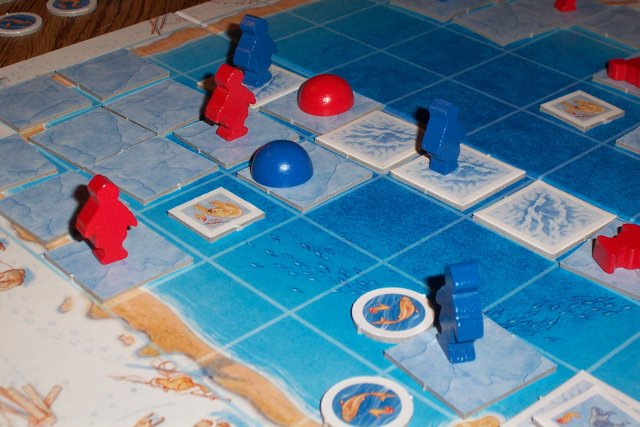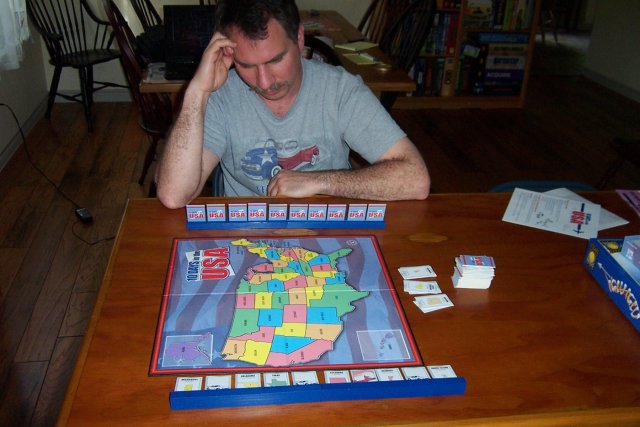
May 31, 2004Session Report for May 27, 2004by Susan Rozmiarek It seems like every game night someone comes up with a funny pun, or I hear something quite odd or startling when one doesn’t know the context. So I am now going to include some of these quotes at the end of session reports. Look for “Overheard at the Table.” It seems like every game night someone comes up with a funny pun, or I hear something quite odd or startling when one doesn’t know the context. So I am now going to include some of these quotes at the end of session reports. Look for “Overheard at the Table.”
Wow, was it ever hard to choose between the choices tonight. Mike brought his minty fresh copy of Power Grid. Funkenschlag is a favorite of mine and I didn’t manage to play this new version at the Gathering. On the other table was Eiszeit, the German version of Mammoth Hunters. This was a Gulf Games prize table pick we’ve been trying to get it to the table for quite some time. Despite the mixed reviews it has received, the fact that it an Alea game and designed by Alan Moon has made me eager to try it. Since I knew Power Grid would probably come out again soon, given its newness, I opted for Eiszeit instead. EiszeitThis is an area majority game with a very attractive board and really cool wooden woolly mammoth pieces. The currency in the game is chips that represent rocks. The board is composed of twelve regions to fight over. The number of regions diminishes during the game as a glacier covers them. Each region has a facedown fire chip that adds to how many hunters that region can hold. Conflicts occur when the number of hunters exceeds the region’s capacity. Mammoths add to this number as well as to the region’s worth when it is scored.The actions on the board are card driven. You get to play one action card on your turn. These actions include adding, removing, and/or moving hunters and mammoths as well as fire chips. The really cool thing is that the cards are divided into two types – light and dark. The light deck is composed of cards that show actions that you, the active player, take. However, there is a varying cost in stone chips to play each one. The dark cards each depict an action that another player gets to take. In most cases, you get to choose the other player. However, instead of paying stones, you GET stones for playing a dark card. This is the only way get the stones necessary to play the light cards that get you actions. This is a very nice balance and provides some very neat nuances to the game. You are forced to play some dark cards and the decision as to who to give the action to is very interesting. Ideally, your choice will not hurt you, but someone else instead. Trying to predict what each player will possibly do with the dark card action reminds me a bit of the card dividing mechanism in San Marco. We started seeing some of the strategies and nuances after a few scoring rounds and the game got quite vicious in the latter half. Our scores ended up being very close. My only criticism is that it was rather long at about 90 minutes. While not as strong as some of the other Alea titles, it is still a worthwhile game and I’m glad we picked it up. I would recommend the English version though, as we constantly had to refer to the card translations in the rules. Results: Ed 46, Susan 44, Francesca 43, Peter 41
Now I had to choose between San Juan and Alhambra with one of the new expansions. Since more people were clamoring for Alhambra, I decided to play San Juan. I’d played it twice already and wasn’t all that impressed. It looks to be a game that gets better as one gets familiar with it, so I wanted to give it another chance. San JuanThere have been a lot of strategy discussions on the internet forums about this game, but I tend to just skim those or avoid them altogether. The only thing that did stick out in my mind from those discussions was the power of the Chapel. So, when I got one of those fairly early I built it and started adding a card to it every round. I also got a Library built early and was able to later add a Black Market and a Quarry. This left me in a pretty sweet spot for building cheaply, especially when able to choose the Builder role and use the Library. Since I was holding a couple of valuable monuments, I decided to focus on building those. Here’s where I made an error, though. I actually had Triumphal Arch in my hand, but I used it to build my Quarry, hoping to draw it later if I did indeed manage to build my monuments. Unfortunately, Mike had built the other Chapel and stuck the Arch under it to take it out of the game. When the game ended, I still managed to squeak out the win over Mike with my loaded Chapel and three monuments netting me lots of points. Both Francesca and Peter managed to do pretty well also, considering it was the first game for both of them.I enjoyed San Juan much more this time. I think this was due to knowing the cards a little better and thus being able to form a plan as the game went on. In my first two games, I felt like I was just building anything whenever I was able. Results: Susan 34, Mike 32, Francesca 28, peter 22
Other games played: Trendy, Alhambra w/expansion, Power Grid Overheard at the Table:
Power Grid: “Because you were excreted first”
For more pictures from this gaming session and others, see our Gaming Picture Gallery.
Posted by susanroz at 12:54 AM
| Comments (0)
May 28, 2004Session Report for May 20, 2004by Susan Rozmiarek The early birds started off with Mü, which was abandoned after one hand as more people showed up. This was just enough to refresh us with the rules and whet our appetite for more. I really, really must play a full game of this! It’s got a learning curve that I’ve barely even begun to explore. The early birds started off with Mü, which was abandoned after one hand as more people showed up. This was just enough to refresh us with the rules and whet our appetite for more. I really, really must play a full game of this! It’s got a learning curve that I’ve barely even begun to explore.
We then played a round of Thingamajig, once again aborting when the last arrivals trickled in. At this point, I was starting to wonder if I was going to play a full game of anything. Fortunately, we now had enough to split into two tables. AfricaIt has been over a year since this light exploration game has hit the table. I don’t find the game terribly exciting, but it’s pleasant enough and not too taxing, making it an excellent choice for family or casual gamers. It has a fair bit of luck but also many tactical decisions. This type of game is often prone to too much group thinking, so it is wise to lay down the laws for table talk before the game starts. Our game had two new players, so we were more liberal than usual with allowing table talk.My explorer excelled as a big game hunter, turning over tile after tile of exotic animals. I was able to build a few camps amongst the wild beasts for some decent points, but then was unable to discover hardly any monuments to acquire additional camps to build. My explorer was also was no Indiana Jones, only able to unearth a few rare artifacts. He did manage to find some valuable gems, which earned him second place in the “most gems” contest. This, coupled with his hunting success, garnered him a tie for second place glories. Results: Doug/Ed 45, Susan/Francesca 42, Roxana 29
Iglu IgluI had played a two-player game of this with Ed and you can read my earlier report for a better description of the game. I was a little apprehensive about playing it with more players as I thought it would become too chaotic. Well, there was more chaos to be sure, but it also was a whole lot of fun with more players fighting for dominance on the ice. On Bruno Faidutti’s website, he currently has an editorial about the trend in German games lately toward non-violence with less player interaction. In comparing older games, he has this to say about Settlers of Catan and El Grande:“There were no battles, but players were still playing on the same map, and there was always a strong rivalry, either to be the first on the most interesting crossings - in Settlers of Catan - or to get the majority and take control of the most interesting areas - in El Grande.” It is no surprise then, that this is the type of game that he and Bruno Cathala have designed with Iglu Iglu, but in their own style, loaded with theme with a good dollop of luck and chaos. While it doesn’t belong up there on the top shelf with those elegant, venerable classics, I find Iglu Iglu to be enjoyable nonetheless. There’s loads of competition between players, with each turn often presenting tactical decisions to either help yourself or hurt someone else, preferably both. And while it is very competitive and has many opportunities for hosing other players, it doesn’t overstep the boundaries of “meanness” for my comfort level. I can see, however, that this game is not going to be to the taste of some players. The constantly changing board and the luck of the tiles makes long-term planning hard. If you like tactical games though, this one has some neat mechanisms, including one that reminds me somewhat of the shifting maze in The aMAZEing Labyrinth. Our game started out with the race to the middle to pluck the largest fish from the frigid waters. Polar bears soon made an appearance, but not the harpoons necessary to defeat them. As islands formed from the melting ice, the competition to control the larger ones became fierce. Francesca was the first to build an igloo on a large center island, but soon learned the error of building one too early as we made sure her island steadily shrank in size. A big island in the corner became very crowded, ensuring that it would retain its size with each tile being occupied. It was Doug who then made a very clever move at the end to win the game. I had a nice island all to myself in one corner with lots of stable, packed ice. Ed was able to chase me off with a rampaging polar bear, leaving the island empty. Doug then kayaked to it and used a Thaw tile he had been saving to melt the very last possible ice tile on the board, triggering the end of the game. This gave him a huge number of points for being the sole occupant of the island. I think the gamer’s variant for scoring looks a bit more balanced and I want to try using it next time along with the blocking rules for igloos. All four of us enjoyed the game, so I’m sure I’ll get a chance soon. Results: Doug 39, Francesca 22, Ed 21, Susan 20
Other games played: Magna Grecia, Can’t Stop, Trendy
For more pictures from this gaming session and others, see our Gaming Picture Gallery.
Posted by susanroz at 3:13 PM
| Comments (0)
May 17, 2004Session Report for May 13, 2004by Susan Rozmiarek I’ve gotten behind on writing session reports lately, but now I’d like to get back on a regular schedule. With summer almost here, I should have more time so this shouldn’t be a problem.
I’ve gotten behind on writing session reports lately, but now I’d like to get back on a regular schedule. With summer almost here, I should have more time so this shouldn’t be a problem.
ThingamajigEd and I played this game at the Gathering and really enjoyed it. Neither of us are fans of party games in general, but this one doesn’t require any type of humiliating performance or knowledge of trivia and/or popular culture. In other words, you can play it without too much danger of looking really stupid. The fact that Ed was willing to play it more than once and suggested buying it says a lot. However, we were concerned that our enjoyment was a result of playing it with people who liked this sort of game and that it would go over like a lead balloon with our own group.The game comes with a “thingamajig,” a little electronic device that has words stored in it. On your turn, you take it and press a button and it shows you a single random word. You then give a verbal clue as to what the word is. The other players secretly make a guess and write it down. All guesses are revealed simultaneously. Every player who guessed correctly gets a plastic chip. The player giving the clue gets a chip for EACH correct guess EXCEPT in the case of everyone guessing correctly. In that case, he gets nothing. He then passes the thingamajig to the next person. The game ends when the pool of chips is depleted. Whoever has the most chips is the winner. We also used a fun variant in which you could offer up a chip as a bet to double your reward for a correct guess or lose the chip for an incorrect one. The idea, of course, is to give easy enough clues that most people guess correctly but not so easy that everyone does. The only problem in our game was that my eleven year-old son, Kevin, was playing. He did fairly well, but it was sometimes easy to give a clue that everyone would get but him. For example, Doug’s word was “Washington” and his clue was “what state is Tacoma in?” Oops. Bad example. Surprisingly, several people didn’t get that one! Despite this, most of us had a lot of fun with the game, with the exception of Mark, who kept asking if it was over yet. This is a great game for non-gamers and perfect for a party or family get-together (I guess that’s why it’s a party game?!?) You could even include more people by adding more chips to the game. However, it doesn’t work quite as well with a mix of kids and adults, although with teens it might work. Results: Ed 20, Doug 16, Susan 15, Mark 13, Jon 12, Rox 11, Kevin 4 Kevin went off to join the other kids playing video games and we were left with six. Doug has been trying to get an older Spiel des Jahres winner, Auf Achse, to the table for awhile, and this seemed like a good time. This game used to be a favorite with our group long ago, but it hadn’t been played for ages. I was curious to see how it well it has stood the test of time against the many, many new games we have played since. Auf AchseAuf Achse is a pickup and delivery game. The winner is the player who earns the most money. Players have trucking contracts that they obtain by auction. Each contract indicates a city where a certain amount of cargo can be picked up and the city where it needs to be delivered to, along with the payout the player will receive when he delivers. Players move a chunky rubber truck around the board by a die roll, picking up cargo and delivering it as they reach the appropriate cities. Trucks, however, can only carry a maximum of 6 units of cargo unless the player purchases a trailer, which adds 4 or 6 more to the payload. Thus it becomes a planning game of choosing contracts that complement each other in planning efficient routes. Also to consider is how much to pay for a contract, as the profit margin gets smaller as the price goes up. To add some random chaos to the game, there are spots on the board that require a player to draw an event card. Some of these are good things and some are bad. Further aggravation comes in the form of construction roadblocks. These are placed when a player rolls a one on the die or when a certain event card is drawn.The game got off to a pretty tame start with Doug being the first to get the money rolling in. I acquired several contracts and bought a trailer early, which allowed me to make a nice double delivery in Berlin. Jon was buying up contracts like crazy for high prices. Ed, on the other hand, stubbornly refused to buy any contract without a high profit margin and spent several turns without any contracts at all. These two strategies at the opposite extremes didn’t seem to work for them. Ed was stung severely by an event card towards the end of the game. He was one spot away from making a delivery and drew a card that required him to go to Munich first. As Munich was close by, this wouldn’t have been a big deal, except two other players were making deliveries in Munich and were both able to grab the spot before Ed could. So, he spent several frustrated turns wandering around the outskirts of Munich, waiting for it to become vacant. Results: Doug 22,700, Rox 20,200, Susan 18,500, Jon 18,100, Mark 17,100, Ed 10,900 This game is okay and I’d play it again, but some of its luster has definitely worn off. At two hours, it takes a little too long and getting around by rolling a die is a bit tedious at times. There are now much more elegant games of this sort that I’d rather play, such as Logistico.
MüWe were now down to five players and decided to try out this trick-taking game from the Mü & More collection. It has a reputation of being very good with five. Because it took awhile to wrap our heads around the rules, we only had time to play a few rounds. All of us were favorably impressed, however, and I’m hoping to play a full game soon. Having to refer to charts is a bit fiddly and distracting, but the mechanisms for choosing the chief and vice were very interesting and have some tricky nuances to explore further.Other games played were Fire & Ice and IQ-5. IQ-5 was a big hit, with a total of six games played tonight.
For more pictures from this gaming session and others, see our Gaming Picture Gallery.
Posted by susanroz at 12:18 PM
| Comments (0)
May 11, 2004Mother's Day Gamingby Susan Rozmiarek With it being Mother’s Day this weekend, my family had to indulge me and play games. Not that I normally have to twist any arms to find players around here!
With it being Mother’s Day this weekend, my family had to indulge me and play games. Not that I normally have to twist any arms to find players around here!
IQ-5We saw this game at the last Gulf Games where my son Shea spent quite a bit of time fooling with it. It’s the old familiar “get x pieces in a row” type of game but with a very interesting twist. The pieces are pellets, which each pellet being two halves of different colors, combos of red, yellow or blue. The board stands upright between players similar to Battleship and is comprised of holes or slots in which you slide the pellets. You can only see your side of the board and not your opponent’s. On your turn, you slide in one of your pieces, so that one color is played on your opponent’s side, and one color is on your side. The first player to get five in a row of a single color, horizontally, vertically or diagonally on his side of the board wins. Remembering where and what colors you placed on your opponent’s board is key, but becomes more difficult as more and more pieces are played. Along with the memory element there is bluffing and a bit of deductive guessing, making the game quite fun and challenging.Shea is pretty good at this sort of thing and smoked me in our first game. He later played Ed and narrowly lost.
Iglu IgluThis is a new game by the Bruno pair, Faiduitti and Cathala. It’s a family game of Inuits hunting animals on melting ice. As one might expect from these two designers, there is quite a bit of chaos and luck in the game. But, there are also opportunities for some clever moves, too. What is particularly interesting is that rather than being a tile-laying game, it is a tile-UNlaying game. Instead of building the board as the game progresses, all the tiles are laid out facedown at the beginning of the game. On each turn, players must “melt” an unoccupied ice tile and remove it (in most cases). The hidden side of the tile contains an event. Some of events take place immediately and others are put aside to be used later. After melting an ice tile, The player then has three action points to spend on moving Inuits, building igloos, and hunting animals.The animals have a number on them that indicates how many action points it takes to defeat them. This number also represents how many victory points it is worth. Inuits must be on the same tile as an animal to defeat it or in the case of fish, on a tile adjacent to the fish. A polar bear can only be defeated by a harpoon. Inuits that can’t defend themselves from a polar bear are removed to one of the corner spaces. Igloos, however, provide a hiding spot for its owner. There are several event tiles that can change the board during the game. An Ice Floe tile lets a player push a row of ice one space, along with anything on that ice. This can create new islands or join others. It can also move animals closer or further away from players. Another tile allows the player to sink a tile, sending any Inuits on it to one of the board’s corners. Other tiles move animals, give extra action points or provide a harpoon, the only weapon that will defeat a polar bear. Other tiles add animals and fish to the board. As the ice melts, islands will be formed. At the end of the game, the islands will be worth victory points for the players with the most Inuits and igloos (count as two Inuits) on them. The game ends when a player cannot melt an ice tile. Victory points from islands and defeated animals are counted up to determine the winner. Ed and I played a two-player game. Despite the high luck factor, we enjoyed it. The end of the game was especially tense, with us both trying to grab majorities of particularly valuable islands. There are a few variants on Bruno Faidutti’s website that are intended for more hardcore gamers. I’m looking forward to trying the game with those next. Also, I’d like to try it with more players, although I expect it will be even more chaotic.
10 Days in the USAI’ve been addicted to 10 Days in Africa lately despite being awful at it. Everyone keeps describing these games as being so light and I’m beginning to feel like an idiot. I decided to get the USA version thinking it would be less frustrating playing with familiar geography. I was right. I could just glance at the cards and know whether or not I was interested, without having to scrutinize the map so closely. It made for so much easier planning. Ed and I played two quick games and I actually won one!I’m planning to get all the games in this series. My kids enjoy it and will learn some geography, I hope. I wouldn’t mind sharpening my own knowledge, particularly if Out of the Box Games publishes new versions with maps of Europe and the Middle East. I think I read somewhere that they were planning to do these.
Posted by susanroz at 3:32 PM
| Comments (2)
May 5, 2004Two new reviewsby Ed RozmiarekWe have posted two new reviews to our Reviews page. They are for Dos Rios and La Strada, two new games available from Mayfair Games. Stop by for a read.
Posted by edroz at 12:28 AM
| Comments (0)
Formula Dé - May Raceby Ed Rozmiarek
Highlights from this month's race included:
The point standings are still very close, with Mark's win pushing him into the lead just ahead of Ed with Roxana dropping back to third overall. As we are half way through our season, the drivers at the bottom of the points totals will need to start placing higher to have a shot at the season championship. See our Formula Dé webpage for the detailed results of today's race or visit the picture gallery for the pictures from the race. Check back with us again next month as we travel to Zeltweg, Austria
Posted by edroz at 12:10 AM
| Comments (0)
This page viewed E-mail Ed Rozmiarek with questions or problems concerning this page. Copyright © 2004, Ed & Susan Rozmiarek. No portion of this website may be reproduced or copied without the consent of Ed or Susan Rozmiarek. |
